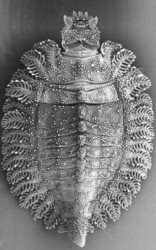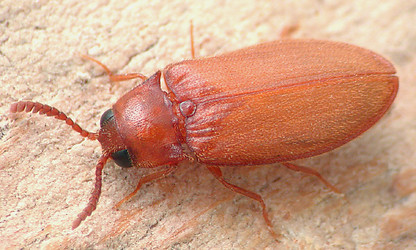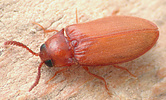Brachypsectridae
Brachypsectra
Cleide Costa and Sergio Antonio Vanin- Brachypsectra fulva LeConte, 1874
- Brachypsectra fuscula Blair, 1930
- Brachypsectra lampyroides Blair, 1930
- Brachypsectra vivafosile Woodruff, 2004
- Brachypsectra moronei Branham, 2006

- Brachypsectra kadleci Hájek, 2010
- Brachypsectra sp. (Australia): Costa et al, 2006
Introduction
The monogeneric family Brachypsectridae includes six extant species, one of them undescribed, from northern Australia known from larvae only and one fossil species known from Miocene amber in the Dominican Republic. Brachypsectra species occur in two disjunct areas: 1) southwestern North America and the Greater Antilles and 2) western Iran, southern India, Singapore and northwestern Australia (Costa et al 2006, 2010; Hájek, 2010).
Adults with body elongate oval, length about 4 to 8 mm, more or less flattened and finely pubescent. They resemble those of certain other basal Elateroidea groups, such as Cerophytidae, Drilidae, or genera normally placed in the lampyrid subfamily Ototretinae. They are easily distinguished from Cerophytidae by numerous features, such as the more flattened body, transverse procoxa, well-developed metacoxal plates and simple tarsal claws. Drilidae and Lampyridae (Ototretinae) may have a similar body form with acute posterior pronotal angles and no tibial spurs, but the prosternal process is highly reduced or absent and the procoxa is strongly projecting. Larvae are distinguished from all other beetle larvae by the combination of broad, flattened, body with lateral branched processes, flexible tail spine, free labrum and perforate mandibles (Costa et al 2006, 2010).
Adults are usually attracted to lights at night. Larvae are usually collected beneath loose bark, in cracks in rock, in leaf bases of monocotyledonous plants or under leaves or other debris on the ground. The larvae are non–specific ambush predators. They have been observed feeding on small arthropods, like spiders, ants and beetle larvae (Fleenor & Taber 1999, Costa et al 2006, 2010).
Characteristics
(modified from Costa et al 2006, 2010)
ADULTS
- Head deeply inserted into prothorax and slightly declined, constricted behind eyes forming very short neck.
- Mouthparts directed ventrally
- Antennal insertions slightly visible from above.
- Frontoclypeal suture absent.
- Antennae 11–segmented, with antennomeres 4 or 5 or 6 to 10 expanded apically on one side to form with the terminal antennomere a pectinate club.
- Mandible without mola or prostheca.
- Procoxal cavities transverse, open internally, and externally.
- Metaventrite discrimen well developed
- Transverse (katepisternal) suture absent
- Metepimeron concealed beneath elytra;
- Metendosternite with long stalk, short, broad arms, weakly developed ventrolateral processes and no medial anterior process
- Hind wing with radial cell; medial field with 5 free veins; wedge cell absent.
- Tibial spurs absent.
- Tarsi 5–5–5; tarsomeres; tarsomere 4 slightly reduced with weak ventral lobe.
- Pretarsal claws simple; empodium visible, bisetose.
- Abdominal ventrites freely articulated; ventrite 1 with acute intercoxal process.
- Aedeagus symmetrical, of trilobate type, penis undivided, with short basal struts.
- Ovipositor with stylus well developed, articulated, terminal.
LARVAE
- Body strongly flattened and disc–like, with moderately long, lateral lobes lined with elongate setiferous lobules on all thoracic segments and abdominal segments I–VIII.
- Head prognathous and protracted, much narrower than prothorax; posterior edge as seen from above more or less emarginate.
- Epicranial stem very short or absent; frontal arms slightly lyriform or sometimes absent; endocarinae absent.
- One large stemma on each side, with well–developed lens.
- Antennae 3–segmented, ventrally concave and more or less concealing mandibles.
- Frontoclypeal suture present or not; labrum free.
- Mandibles symmetrical, perforate with completely enclosed internal channel, without mola or prostheca, retinaculum weakly developed or absent.
- Ventral mouthparts moderately retracted; maxillary articulating area absent; galea articulated; lacinia fixed.
- Labium with mentum and submentum fused; postmentum completely fused to stipes on each side; labial palps 2–segmented; ligula absent.
- Hypopharynx without sclerome. Gular sutures approximate or absent.
- Thoracic terga and abdominal terga I–VIII bearing on each side a pair of laterotergal lobes; thoracic lobes well developed, completely lined with narrow, setiferous lobules.
- Meso– and metaterga, each bearing at its apex a pair of glandular papillae arising together from a single base and aligned longitudinally, with one anterior to the other.
- Tergum VIII without median projection.
- Tergum IX forming articulated plate.
- Procoxal cavities separated by slightly more than greatest coxal diameter; meso– and metacoxal cavities separated by about two coxal diameters.
- Legs well developed, with tibiotarsus slightly longer than femur and pretarsus forming claw bearing a pair of setae. Spiracles biforous; all spiracles with closing apparatus.
Taxonomy
LeConte (1874) described B. fulva and tentatively placed it in the family Rhipiceridae based on a resemblance to Zenoa Say (now in Callirhipidae). Horn (1881) placed the genus in a new tribe, Brachypsectrini, within the family Dascillidae, and this was followed by LeConte and Horn (1883). Forbes (1926) concluded that wing folding in Brachypsectra was of the type found in Elateridae and Lampyridae, but not in Dascillidae. Blair (1930) noted a resemblance to Cerophytum Latreille and suggested that Brachypsectra might occupy a position between that genus and the Elateridae, based on adult structures; and, concluded that the taxon should be raised to family rank, allied more closely to Elateridae than to Dascillidae. Böving and Craighead (1931), apparently following Barber (1905), included Brachypsectridae in Cantharoidea and suggested affinities with Drilidae based on larvae. Crowson (1951, 1955) placed Brachypsectra in Cantharoidea; however, in 1973, he concluded that the taxon could not be placed in Dascilloidea, Elateroidea or Cantharoidea and that its nearest relations were to Callirhipidae and Artematopidae ; as a result he placed all three families in a new superfamily, Artematopoidea. Hlavac (1975) redefined Artematopoidea to exclude Callirhipidae but included Cerophytidae. Kasap and Crowson (1975) returned Brachypsectridae to Cantharoidea.
Lawrence and Newton (1982) published the first comprehensive cladistic analysis on Coleoptera and considered Brachypsectridae and Artematopodidae to form a monophyletic group with those families normally included in Elateroidea and Cantharoidea. The inclusion of all these in a single superfamily Elateroidea was proposed by Lawrence (1988) and Lawrence and Newton (1995). Synapomorphies of Elateroidea in this new sense include the single pair of well–developed stemmata, loss of a mandibular mola, presence of a consolidated maxillolabial complex and extraoral feeding in the larvae, and adults with transverse metakatepisternal suture, derived elateroid wing venation and presence of only four Malpighian tubules.
Costa et al. (2006), revised the family Brachypsectridae, redescribed adults and larvae, gave new data on the geographical distribution and summarized the biological data. The three described species of Brachypsectra LeConte were reviewed (larvae and adults) and B. moronei Branham 2006 was described from the Dominican amber; larvae of an unnamed species from Australia were also described. Hájek (2010) described Brachypsectra kadleci, a new species from western Iran.
Classification
(Based on Lawrence & Newton, 1995; Costa et al, 2006 and Hájek, 2010).
Coleoptera, Polyphaga, Elateriformia, Elateroidea
Brachypsectridae
Brachypsectra LeConte (1874)
- B. fulva LeConte, 1874
- B. fuscula Blair, 1930
- B. lampyroides Blair, 1930
- B. vivafosile Woodruff, 2004
- B. moronei Branham, 2006 (fossil)
- B. kadleci Hájek, 2010
- Brachypsectra sp. (Australia): Costa et al, 2006
Relationships of Brachypsectridae to other Elateroidea
Cladograms produced by Lawrence (1988) and Lawrence et al (1995) showed Brachypsectridae to be at or near the base of Elateroidea sensu stricto (Cerophytidae, Eucnemidae, Throscidae and Elateridae) or sensu lato (also including the cantharoid families) based on both adult and larval characters. In Beutel’s (1995) analysis of Elateriformia based on larval characters alone, Brachypsectridae always clustered with Cantharoidea based mainly on the channelled mandibles.
Presently available data on both adult and larva support previous conclusions that the family Brachypsectridae is a basal member of the Elateroidea as broadly defined by Lawrence and Newton (1982), including Artematopodidae, as well as those families previously included in Cantharoidea and Elateroidea. However, relationships within this group are not well understood, and many problems remain unsolved, including cantharoid monophyly and the positions of Cerophytidae and Anischiidae.
References
Barber, H. S. 1905. Illustrations of an undetermined coleopterous larva. Proceedings of the Entomological Society of Washington 7: 117–121.
Beutel, R. G. 1995. Phylogenetic analysis of Elateriformia (Coleoptera: Polyphaga) based on larval characters. Journal of Zoological Systematics and Evolutionary Research 33: 145–171.
Blair, K. G. 1930. Brachypsectra, Lec. The solution of an entomological enigma. Transactions of the Royal Entomological Society of London 78: 45–50, 1 pl.
Böving, A. G. & Craighead, F. C. 1931. An illustrated synopsis of the principal larval forms of the Coleoptera. Entomologica Americana (N.S.) 11: 1–351.
Costa, C., Vanin, S. A., Lawrence, J. F., Ide, S. & Branham, M. A. 2006. Review of the family Brachypsectridae (Coleoptera: Elateroidea). Annals of the Entomological Society of America 99 (3): 409–432.
Costa, C., Vanin, S. A., Lawrence, J. F., Ide, S. & Branham, M. A. 2010. 4.3. Brachypsectridae Horn, 1881. p. 47-54. In Leschen, R. A. B., R. G. Beutel & J. F. Lawrence (eds). Coleoptera, Beetles: Morphology and Systematics (Elateroidea, Bostrichiformia, Cucujiformia partim). Volume 2, 786 p. In: N. P. Kristensen & R. G. Beutel (eds). Handbook of Zoology, Arthropoda: Insecta, Walter de Gruyter GmbH & Co.KG, Berlin.
Crowson, R. A. 1951. The classification of the families of British Coleoptera [part]. Entomologist's Montlhy Magazine 87: 117-128.
Crowson, R. A. 1955. The Natural Classification of the Families of Coleoptera. 187 pp., N. Lloyd, London.
Crowson, R. A. 1973. On a new superfamily Artematopoidea of polyphagan beetles, with the definition of two new fossil genera from the Baltic Amber. Journal of Natural History 7: 225–238.
Fleenor, S. B. & Taber, S. W. 1999. Review of Brachypsectra with a new record of the Texas Beetle (B. fulva LeConte; Coleoptera: Brachypsectridae). The Coleopterists Bulletin 53: 359–364.
Forbes, W. T. M. 1926. The wing–folding patterns of the Coleoptera. Journal of the New York Entomological Society 34: 42–68, 91–139.
Hájek, J. 2010. Brachypsectra kadleci sp.nov. from Western Iran – the first Palaearctic member of the family Brachypsectridae (Insecta: Coleoptera:Elateriformia). Annales Zoologici 60 (1): 29-33.
Hlavac, T. F. 1975. The prothorax of Coleoptera: (except Bostrichiformia Cucujiformia). Bulletin of the Museum of Comparative Zoology 147: 137–183.
Horn, G. W. 1881. Notes on Elateridae, Cebrionidae, Rhipiceridae, and Dascyllidae. Transactions of the American Entomological Society 9: 76–90, 2 pls.
Kasap, H. & Crowson, R. A. 1975. A comparative anatomical study of Elateriformia and Dascilloidea (Coleoptera). Transactions of the Royal Entomological Society of London 126: 441–495.
Lawrence, J. F. 1988. Rhinorhipidae, a new beetle family from Australia, with comments on the phylogeny of the Elateriformia. Invertebrate Taxonomy 2: 1–53.
Lawrence, J. F. & Newton, A. F., Jr. 1982. Evolution and classification of beetles. Annual Review of Ecology and Systematics 13: 261–290.
Lawrence, J. F. & Newton, A. F., Jr. 1995. Families and subfamilies of Coleoptera (with selected genera, notes, references and data on family–group names). Pp. 779–1092 in Pakaluk, J. & Ślipiński, S. A. (eds.), Biology, phylogeny, and classification of Coleoptera: papers celebrating the 80th birthday of Roy A. Crowson. Muzeum i Instytut Zoologii PAN, Warszawa.
LeConte, J. L. 1874. Descriptions of new Coleoptera chiefly from the Pacific slope of North America. Transactions of the American Entomological Society 5: 43–72.
Title Illustrations

| Scientific Name | Brachypsectra kadleci |
|---|---|
| Comments | Holotype specimen |
| Specimen Condition | Dead Specimen |
| Identified By | Jiří Hájek |
| Sex | Male |
| Life Cycle Stage | adult |
| View | dorsal |
| Size | 5.2 mm |
| Copyright | © 2010 Jiří Hájek |
| Scientific Name | Brachypsectra fulva |
|---|---|
| Specimen Condition | Dead Specimen |
| Identified By | John Lawrence |
| Life Cycle Stage | larva |
| View | dorsal |
| Size | 15.0 mm |
| Copyright |
©

|
| Scientific Name | Brachypsectra |
|---|---|
| Location | Mexico: Sonora, Guaymas area, Nacapule Canyon |
| Specimen Condition | Dead Specimen |
| Image Use |
 This media file is licensed under the Creative Commons Attribution License - Version 3.0. This media file is licensed under the Creative Commons Attribution License - Version 3.0.
|
| Copyright |
© 2005 David R. Maddison

|
About This Page
We thank John F. Lawrence (CSIRO) and Jiří Hájek (Naródini Muzeum, Praha, Czech Republic) for permission to use the larva scanning electron micrographs and adult photograph, respectively; to Ricardo P. Vanin for the electronic treatment of the larva figure. To Conselho Nacional de Desenvolvimento Científico e Tecnológico (CNPq) for the Research Grant 302721/2007 – 0 to C. Costa.
Cleide Costa

Museu de Zoologia, Universidade de Săo Paulo, Brasil

Departamento de Zoologia, Instituto de Biocięncias, Universidade de Săo Paulo
Correspondence regarding this page should be directed to Cleide Costa at and Sergio Antonio Vanin at
Page copyright © 2011 Cleide Costa and
 Page: Tree of Life
Brachypsectridae. Brachypsectra.
Authored by
Cleide Costa and Sergio Antonio Vanin.
The TEXT of this page is licensed under the
Creative Commons Attribution-NonCommercial License - Version 3.0. Note that images and other media
featured on this page are each governed by their own license, and they may or may not be available
for reuse. Click on an image or a media link to access the media data window, which provides the
relevant licensing information. For the general terms and conditions of ToL material reuse and
redistribution, please see the Tree of Life Copyright
Policies.
Page: Tree of Life
Brachypsectridae. Brachypsectra.
Authored by
Cleide Costa and Sergio Antonio Vanin.
The TEXT of this page is licensed under the
Creative Commons Attribution-NonCommercial License - Version 3.0. Note that images and other media
featured on this page are each governed by their own license, and they may or may not be available
for reuse. Click on an image or a media link to access the media data window, which provides the
relevant licensing information. For the general terms and conditions of ToL material reuse and
redistribution, please see the Tree of Life Copyright
Policies.
- First online 01 February 2011
- Content changed 01 February 2011
Citing this page:
Costa, Cleide and Sergio Antonio Vanin. 2011. Brachypsectridae. Brachypsectra. Version 01 February 2011 (under construction). http://tolweb.org/Brachypsectra/65677/2011.02.01 in The Tree of Life Web Project, http://tolweb.org/












 Go to quick links
Go to quick search
Go to navigation for this section of the ToL site
Go to detailed links for the ToL site
Go to quick links
Go to quick search
Go to navigation for this section of the ToL site
Go to detailed links for the ToL site